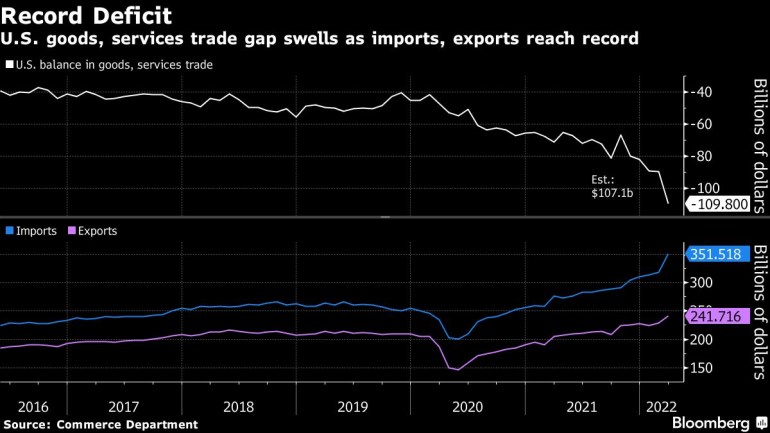US trade deficit hits record as goods imports surge
The gap in goods and services trade grew 22.3 percent to $109.8bn, the Commerce Department has said.

The U.S. trade deficit widened to a record in March, reflecting a surge in imports as companies relied on foreign producers to meet solid domestic demand.
The gap in goods and services trade grew 22.3% to $109.8 billion, Commerce Department data showed Wednesday. The median estimate in a Bloomberg survey of economists called for a $107.1 billion deficit. The figures aren’t adjusted for inflation.

In the first quarter, the widening of the trade deficit largely explains the economy’s worst performance since the pandemic recovery, with gross domestic product shrinking at a 1.4% annual pace. That’s because the value of products American businesses and consumers bought from overseas outpaced purchases of U.S. goods and services by other economies.
Keep reading
list of 4 itemsBiden seeks additional funds to keep Ukraine aid ‘flowing’
Once bound by trade, China-EU honeymoon sours over Ukraine war
US Congress agrees to revoke Russia’s trade status. What now?
Net exports subtracted 3.2 percentage points from first-quarter GDP, government figures showed last week.
An improvement in the trade shortfall any time soon will be difficult as U.S. demand exceeds economic activity in many other nations. Severe lockdowns in China to curb the spread of Covid-19 further complicates the trade picture. Activity at some ports slowed sharply, further straining already-tenuous global supply chains.
The value of imports of goods and services rose 10.3% in March to $351.5 billion and exports increased 5.6% to $241.7 billion. Both values were records.
U.S. merchandise imports grew 12% to a record $298.8 billion, reflecting a surge in the value of industrial supplies that include petroleum. Energy prices rallied in the month after Russia’s invasion of Ukraine. Imports of consumer goods, capital equipment and automobiles also increased.
On an inflation-adjusted basis, the March merchandise-trade deficit widened 18.9% to a record $137.8 billion.
Digging Deeper
- The nominal merchandise-trade deficit widened to $128.1 billion
- Travel exports — or spending by visitors to the U.S. — rose slightly to $8.4 billion
- Travel imports, a measure of Americans traveling abroad, climbed to $7.5 billion, the highest since the start of the pandemic
- Petroleum imports increased to $24.8 billion, the highest since 2014
- Value of imported industrial supplies rose to the highest since 2008, capital goods reached a record
(Adds graphic)
–With assistance from Chris Middleton.